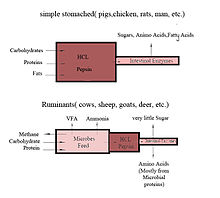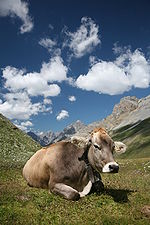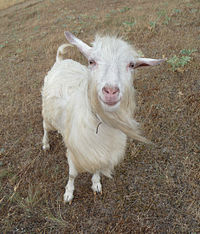- Ruminant
-
Ruminants 
Rough illustration of a ruminant digestive system Scientific classification Kingdom: Animalia Phylum: Chordata Class: Mammalia Order: Artiodactyla Suborder: Ruminantia Families Antilocapridae
Bovidae
Cervidae
Giraffidae
Moschidae
TragulidaeA ruminant is a mammal of the order Artiodactyla that digests plant-based food by initially softening it within the animal's first compartment of the stomach, principally through bacterial actions, then regurgitating the semi-digested mass, now known as cud, and chewing it again. The process of rechewing the cud to further break down plant matter and stimulate digestion is called "ruminating". There are about 150 species of ruminants which include both domestic and wild species. Ruminating mammals include cattle, goats, sheep, giraffes, bison, moose, elk, yaks, water buffalo, deer, camels, alpacas, llamas, antelope, pronghorn, and nilgai. Taxonomically, the suborder Ruminantia includes all those species except the camels, llamas, and alpacas, which are Tylopoda. Therefore, the term 'ruminant' is not synonymous with Ruminantia. The word "ruminant" comes from the Latin ruminare, which means "to chew over again".
Contents
Explanation
The primary difference between a ruminant and non-ruminant (called monogastrics, such as humans, dogs, and pigs) is that ruminants have a four-compartment stomach. The four parts of the stomach are rumen, reticulum, omasum, and abomasum. In the first two chambers, the rumen and the reticulum, the food is mixed with saliva and separates into layers of solid and liquid material. Solids clump together to form the cud or bolus. The cud is then regurgitated, chewed slowly to completely mix it with saliva and to break down the particle size. Fiber, especially cellulose and hemi-cellulose, is primarily broken down into the three volatile fatty acids, acetic acid, propanoic acid and beta-hydroxybutyric acid, in these chambers by microbes (bacteria, archaea, protozoa, and fungi). Protein and non-structural carbohydrate (pectin, sugars, starches) are also fermented.
Even though the rumen and reticulum have different names they represent the same functional space as digesta can move back and forth between them. Together these chambers are called the reticulorumen. The degraded digesta, which is now in the lower liquid part of the reticulorumen, then passes into the next chamber, the omasum, where water and many of the inorganic mineral elements are absorbed into the blood stream. After this the digesta is moved to the true stomach, the abomasum. The abomasum is the direct equivalent of the monogastric stomach (for example that of the human or pig), and digesta is digested here in much the same way. Digesta is finally moved into the small intestine, where the digestion and absorption of nutrients occurs. Microbes produced in the reticulorumen are also digested in the small intestine. Fermentation continues in the large intestine in the same way as in the reticulorumen.
Almost all the glucose produced by the breaking down of cellulose and hemi-cellulose is used by microbes in the rumen, and as such ruminants usually absorb little glucose from the small intestine. Rather, ruminants' requirement for glucose (for brain function and lactation if appropriate) is made by the liver from propionate, one of the volatile fatty acids made in the rumen.[citation needed]
 Comparison of stomach glandular regions from several mammalian species. Yellow: esophagus; green: aglandular epithelium; purple: cardiac glands; red: gastric glands; blue: pyloric glands; dark blue: duodenum. Frequency of glands may vary more smoothly between regions than is diagrammed here. Asterisk (ruminant) represents the omasum, which is absent in Tylopoda (Tylopoda also has some cardiac glands opening onto ventral reticulum and rumen[2]) Many other variations exist among the mammals.[3][4]
Comparison of stomach glandular regions from several mammalian species. Yellow: esophagus; green: aglandular epithelium; purple: cardiac glands; red: gastric glands; blue: pyloric glands; dark blue: duodenum. Frequency of glands may vary more smoothly between regions than is diagrammed here. Asterisk (ruminant) represents the omasum, which is absent in Tylopoda (Tylopoda also has some cardiac glands opening onto ventral reticulum and rumen[2]) Many other variations exist among the mammals.[3][4]
Classification
Hofmann and Stewart divided ruminants into three major categories based on their feed type and feeding habits: concentrate selectors; intermediate types; and grass/roughage eaters, with the assumption that feeding habits in ruminants cause morphological differences in their digestive systems, including salivary glands, rumen size, and rumen papillae.[5][6] There are also pseudo-ruminants having three-compartment stomach instead of four like ruminants. Guinea pigs, horses and rabbits are not ruminants as they have an enlarged cecum allowing the easy digestion of fibrous materials. Such animals are called hind-gut fermenters.
Abundance, distribution, and domestication
Wild ruminants number at least 75 million and are native to all continents except Australia and Antarctica. Nearly 90% of all species are found in Eurasia and Africa alone. Species inhabit a wide range of climates (from tropic to arctic) and habitats (from open plains to forests).[7]
The population of domestic ruminants is greater than 3.5 billion, with cattle, sheep, and goats accounting for about 95% of the total population. Goats were domesticated in the Near East at approximately 8,000 B.C. Most other species were domesticated by 2,500 B.C., either in the Near East or southern Asia.[8]
Ruminant physiology
Ruminating animals have various physiological features which enable them to survive in nature. One feature of ruminants is their continuously growing teeth. During grazing, the silica content in forage causes abrasion of teeth. Abrasion of the teeth is compensated by continuous tooth growth throughout the ruminant's life, as opposed to humans or other non-ruminants whose teeth stop growing after a particular age. Ruminants do not have upper incisors,[9] instead they have a thick dental pad to thoroughly bite food.
Rumen microbiology
Vertebrates lack the ability to hydrolyse beta [1-4] glycosidic bond of plant cellulose due to the lack of an enzyme celulase. Thus ruminants must completely depend upon the microbial flora, present in rumen or hindgut, so as to digest cellulose. Digestion of food in rumen is primarily carried out by the rumen microflora which contain dense populations of several species of bacteria, protozoa, sometimes yeasts and fungi. It is estimated that 1mm of rumen contains 10-50 billion bacteria, 1 million protozoa and several yeasts, fungi.[10] As the environment inside a rumen is anaerobic, most of these microbial species are obligate or facultative anaerobes which can decompose complex plant material such as cellulose, hemicellulose, starch, proteins. Hydrolysis of cellulose results in sugars which are further fermentated to acetate, lactate, propionate, butyrate, carbon dioxide and methane.
During grazing, ruminants produce large amount of saliva. Estimates are within 100 to 150 litres of saliva per day for an adult cow.[11] The role of saliva is to provide ample fluid for rumen fermentation and as a buffering agent.[12] Rumen fermentation produces large amounts of organic acids and thus maintaining the appropriate pH of rumen fluids is a critical factor in rumen fermentation.
Tannin toxicity in ruminant animals
Tannins are phenolic compounds that are commonly found in plants. These compounds play a role in protection from predation, as well as growth regulation, when they are digested by herbivores. Found in the leaf, bud, seed, root, and stem tissues, tannins are widely distributed in many different species of plants. Tannins are separated into two classes: hydrolysable tannins and condensed tannins. Depending on their concentration and nature either class can have adverse or beneficial effects. When ruminants digest some plants, they acquire a surplus of tannins and rumen microbes do not have the enzymatic ability for degrading condensed tannins. In fact, digestion of tannins by ruminants in large amounts can reduce the activity and the proliferation of ruminal microorganisms reducing ruminal biohydrogenation.[13] Tannins can also precipitate proteins and inhibit the absorption of nutrients.[14] Very high levels of tannin intake can produce toxicity that can even cause death. Animals normally consuming tannin-rich plants can develop defensive mechanisms against tannins, such as the strategic deployment of lipids and extracellular polysaccharides that have a high affinity to binding to tannins.[15] These mechanisms prevent tannins from causing adverse effects on rumen microbes.
Religious importance
In Abrahamic religions, a distinction between clean and unclean animals approximately falls according to whether the animal ruminates. The Law of Moses in the Bible allowed only the eating of animals that had cloven hooves and "that chew the cud",[16] a stipulation preserved to this day in the Jewish laws of Kashrut.
Other uses
The verb to ruminate has been extended metaphorically to mean to ponder thoughtfully or to meditate on some topic. Similarly, ideas may be chewed on or digested. Chew the (one's) cud is to reflect or meditate. In psychology, "rumination" refers to a pattern of thinking, and is unrelated to digestive physiology.
Ruminants and climate change
Methane has 23 times the warming potential of carbon dioxide and its production by ruminants may contribute to a greenhouse effect or climate change. Methane production by animals, principally ruminants, is estimated 15-20% global production of methane.[17][18] The rumen is the major site of methane production in ruminants.[19]
Examples of ruminants
See also
References
- ^ Russell,J. B. 2002. Rumen Microbiology and its role In Ruminant Nutrition.
- ^ William O. Reece (2005). Functional Anatomy and Physiology of Domestic Animals. ISBN 9780781743334. http://books.google.com/books?id=gvt_qSsLobUC&pg=PA350&lpg=PA350&dq=tylopoda+omasum.
- ^ Esther J. Finegan and C. Edward Stevens. "Digestive System of Vertebrates". http://www.cnsweb.org/digestvertebrates/WWWEdStevensCDAnatomy.html.
- ^ Muhammad Khalil. "The anatomy of the digestive system". http://www.onemedicine.tuskegee.edu/DigestiveSystem/Stomach/Stomach_Ruminants.html.
- ^ Ditchkoff, S. S. (2000). "A decade since "diversification of ruminants": has our knowledge improved?". Oecologia 125: 82–84. doi:10.1007/PL00008894. https://fp.auburn.edu/sfws/ditchkoff/PDF%20publications/2000%20-%20Oecologia.pdf.
- ^ Hofmann. R. R. 1989."Evolutionary steps of ecophysiological and diversification of ruminants :a comparative view of their digestive system". Oecologia, 78:443-457
- ^ Hackmann. T. J., and Spain, J. N. 2010."Ruminant ecology and evolution: Perspectives useful to livestock research and production". Journal of Dairy Science, 93:1320-1334
- ^ Hackmann. T. J., and Spain, J. N. 2010."Ruminant ecology and evolution: Perspectives useful to livestock research and production". Journal of Dairy Science, 93:1320-1334
- ^ Ruminant facts
- ^ Rumen ecology
- ^ Some physical and chemical properties of Bovine saliva which may affect rumen digestion and synthesis Journal of Dairy Science Vol 32 (2) , p. 123-132, 1949.
- ^ Rumen physiology
- ^ Vasta, V., H. P. S. Makkar, M. Mele, and A. Priolo (2009). Ruminal biohydrogenation as affected by tannins in vitro. 102. Br. J. Nutr. pp. 82–92.[1]
- ^ Bate-Smith and Swain (1962). "Flavonoid compounds". In Florkin M., Mason H.S.. Comparative biochemistry. III. New York: Academic Press. pp. 75–809.[2]
- ^ Min, B. R., T. N. Barry, G. T. Attwood, and W. C. McNabb. (2003). The effect of condensed tannins on the nutrition and health of ruminants fed fresh temperate forages: a review.. Anim. Feed Sci. Technol. pp. 106:3–19. [3]
- ^ Leviticus 11:6
- ^ Cicerone, R. J., and R. S. Oremland. 1988 "Biogeochemical Aspects of Atmospheric Methane"
- ^ Yavitt, J. B. 1992. Methane, biogeochemical cycle. Pages 197–207 in Encyclopedia of Earth System Science, Vol. 3. Acad.Press, London, England.
- ^ Asanuma. N., M. Iwamoto, T. Hino. 1999."Effect of the addition of fumarate on methane production by ruminal microorganisms in vitro." J. Dairy Sci.82:780–787
External links
- Digestive Physiology of Herbivores - Colorado State University
Categories:- Herbivorous animals
- Even-toed ungulates
Wikimedia Foundation. 2010.



